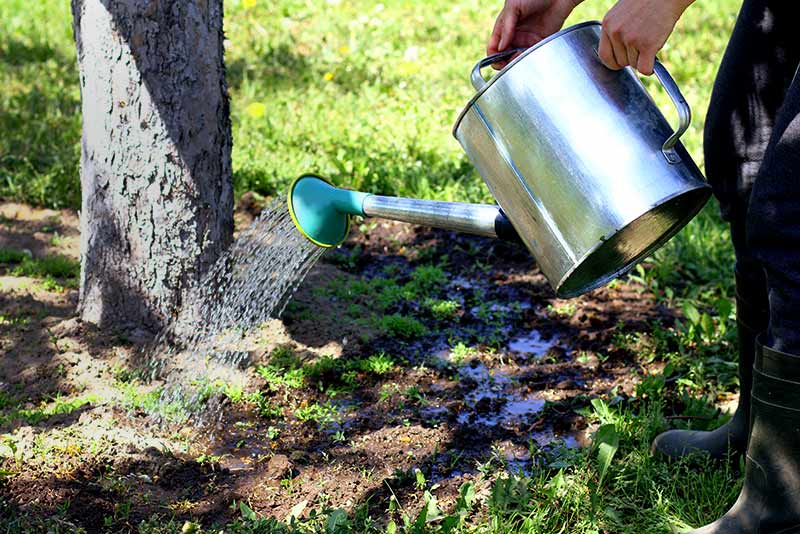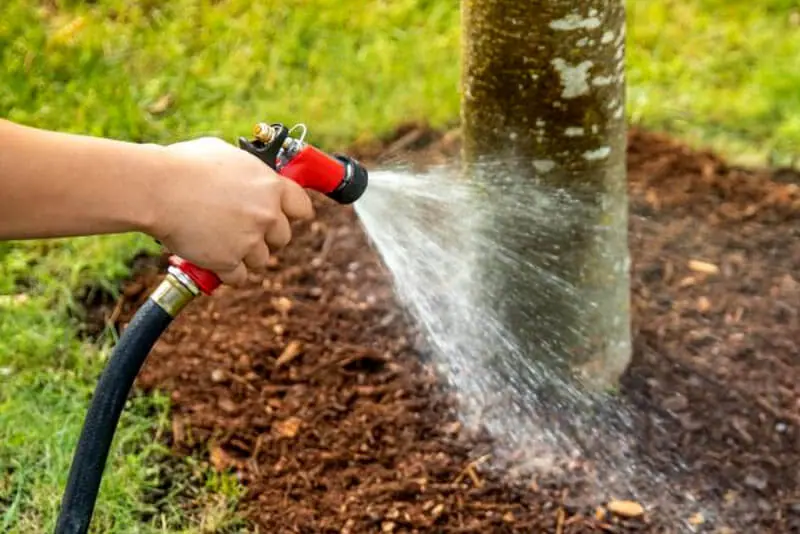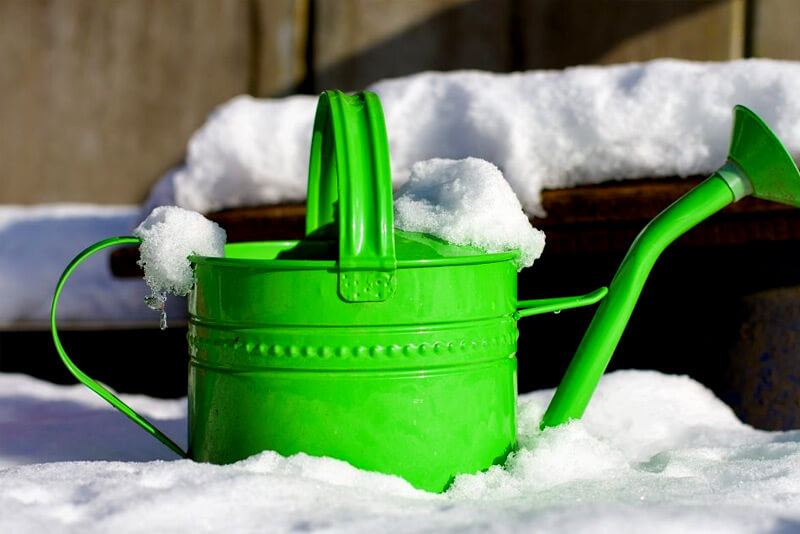Newly planted trees require more frequent watering than with established root systems. The question is how much to water the new tree1 and when to water it.
The amount of water needed for a newly planted tree depends on the caliper of the tree trunk. Give a new tree 1 to 1.5 gallons of water per inch of trunk diameter. However, this is not a general rule of thumb for all trees but it is a good start and orientation for you.
Before you admire your landscape you need a good plan that includes a watering schedule and maintenance of the tree. You will find all this in this article.

The amount of water for a new tree
As I mentioned in the introduction paragraph, the amount of water depends on the tree trunk’s diameter. In the table below you will find approximate figures for the amount of water needed.
| Tree trunk dimensions (inch) | Establishment time (years) | Amount of water per irrigation (gallons) |
|---|---|---|
| 1 | 1.5 | 1 - 1.5 |
| 2 | 3 | 2 - 3 |
| 3 | 4.5 | 3 - 4.5 |
| 4 | 6 | 4 - 6 |
| 5 | 7.5 | 5 - 7.5 |
| 6 | 9 | 6 - 9 |
Tree root establishing time
The root system of a newly planted tree or a shrub is considered established when root spread equals the spread of the above-ground canopy.
Since establishment time for trees increases with tree size, you can use the trunk caliper at planting time to determine the time needed for roots to establish.
How to find the caliper of your tree?
- Measure the diameter of the trunk at 6” above the ground for diameters up to 4”
- If the diameter is more than 4”, measure at 12” above the ground.
Watering schedule – where and when to water the tree?
The first day – the initial irrigation
It is very important you water the tree thoroughly as soon as you plant it. Keep the planting area and the surrounding soil evenly moist because most of the tree’s roots are still within the original root ball, but do not flood the area as this will just displace the soil. A few ways are pretty effective in keeping the soil evenly moist. This includes a slow drip system, a soaker hose, or drip irrigation.
1 to 2 weeks
The root ball and the surrounding planting area must be wet, so water daily.
- If you plant your tree in the season when temperatures are cooler, such as fall, water the tree daily for the period of one week;
- You may continue with daily watering if you plant your tree in the spring when temperatures are gradually getting warmer;
- Of course you don’t have to water the tree when it rains.
3 to 10 weeks
In the next several weeks the watering schedule will mainly depend on the climate of your area but in general water every 2 to 3 days. Factors such as the time of the year when the tree is planted, rainfall, and temperatures will directly affect how much you will need to water your tree.
- You will not have to water the tree as often as every three days if you plant the tree in early spring and live in a climate that gets frequent spring and summer rain;
- On the other hand, if you plant the tree in spring but your climate is dry with hot summers it is recommended to water the newly planted tree every 2 to 3 days.
- Allow only the first 2 to 3 inches of soil to dry out before soaking again;
- As the tree is getting established be sure to keep the top 12 inches of soil around a newly planted tree consistently and evenly moist.
10 weeks
Water your tree once a week until the roots are established. This time varies from species to species and climate to climate, but it usually takes 2 to 3 years.
Water a newly planted tree once a week during the hottest, driest time of the year as trees become more established. Also, don’t forget to water regularly even if the tree has gone dormant. Continue watering your tree until the ground freezes or temperatures drop below freezing.
Where to water a new tree?
Not only the amount of water is vital for a newly planted tree. Where to water2 the tree also has a crucial role in the whole process. Follow the tips below.
- Water directly over the root ball;
- Backfill soil in the planting hole must be moist so the roots can expand beyond the root ball into the backfill soil;
- As the roots grow approximately 15 to 18 inches per year you must expand the area you are watering over time;
- Create a water pool or reservoir by making a circular heap of earth 3” to 4” high around the plant at the edge of the root ball;
- A slow trickle of water can help fill the reservoir to allow water to infiltrate into and around the root ball slowly.

How to maximize the water uptake?
When a new tree has been planted the battle for nutrients occurs below the surface immediately. Normally existing turf and weeds win this battle because they have a dense fibrous root system that prevents newly planted trees from producing water and nutrient-absorbing roots in the top few inches of soil.
Follow the tips below to maximize the water uptake:
- Clean the base of the plant out to several feet beyond the plant canopy from turf and weeds;
- Use organic mulch. Start the mulch application at the outer edge of the root ball. Also, leave the top of the root ball bare;
- Apply around a 3-inch layer of mulch around the newly planted tree. Mulch should be added in a circle that extends several feet beyond the tree.
Pros of mulching
- Less water evaporation from the soil;
- Prevents runoff around trees growing in heavy clay soils or on sloped sites;
- Provides control of seed germination and weed growth;
- Good insulation to the soil during extreme summer and winter temperatures;
- Reduces soil compaction from mowing equipment, and prevents damage to stems and trunk;
- Improves soil health as it decomposes.
Cons of deep mulching application
- Prevent movement of rain and irrigation water into the root ball. This can lead to root drying and tree stress;
- Can reduce the oxygen levels around roots and cause root suffocation;
- The tree bark will be excessively wet which can lead to bark decay;
- Can create a good environment for rodents that chew bark and girdle trunks and stems;
Final tips
Some of these final tips will help you during the tree establishment and will give you the best from your tree and all the effort around it.
Deeper is better
“How” to water the tree is one of the most important things. My answer to this question is slow and deep. Drip lines are maybe the best method for watering, but a garden hose will also do the job. Another benefit of using drip lines is less water loss to evaporation.
Consistency matters
Don’t let the soil completely dry out but also don’t allow it to stay soggy. Both situations will result in a tree that is stressed and more prone to disease and infestation. So keep the soil consistently moist without big oscillations in the irrigation process.
Choosing the right species
This plays a crucial role. According to the climate of the area you live in you should choose the species. For example, in regions where drought is typical, you should go with the drought-tolerant species. Drought-tolerant trees and shrubs are adapted to dry climates and will grow better and help conserve water as well.
FAQ’s
Can you overwater a newly planted tree?
A newly planted tree needs the right amount of water to grow into a healthy and beautiful tree. Too little water and the tree will wilt and die, and too much water can drown the roots and kill the tree eventually.
Should I water my trees in winter?
Yes! You should irrigate your trees and shrubs in the winter during dry spells. Dormant trees are growing too. It is advised to water when air and soil temperatures are above 40℉ and when there is no snow cover.

How do I know if my tree has enough water?
When it comes to a newly planted tree, test the dirt at the base of the tree and for an established tree, test the root zone. Roll a small amount of dirt, not mulch, between your fingers. If the dirt sticks together, there is adequate moisture present. If it is crumbly and dry, you should water it.
- Kathy Zuzek, (2018) Watering newly planted trees and shrubs. <https://extension.umn.edu/planting-and-growing-guides/watering-newly-planted-trees-and-shrubs> Accessed: 19-03-2024
- John Lang, (2018) How to Properly Water Your Trees. <https://arbordayblog.org/treecare/how-to-properly-water-your-trees/> Accessed: 19-03-2024




